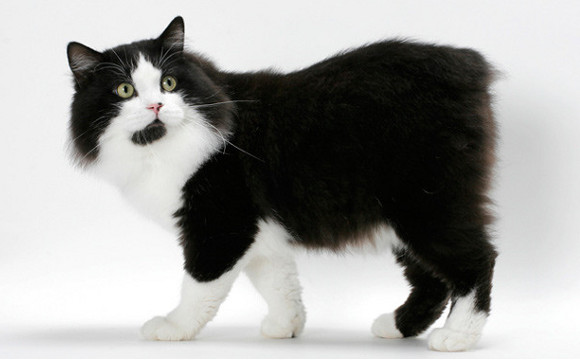History and Origin
The Cymric cat is a long-haired version of the Manx cat, both originating from the Isle of Man in the Irish Sea. This unique breed likely arrived with early human settlers, with possible contributions from the Spanish Armada, Phoenician traders, or Viking settlers. Researchers believe the British Shorthair was later integrated into the Manx gene pool due to geographic proximity and similar body styles.
The distinctive tailless trait of the Cymric and Manx cats is governed by a dominant gene, unlike the recessive gene that controls tail length in breeds like the Japanese Bobtail. Historical records indicate that the tailless mutation arose naturally among the island’s domestic cat population rather than being imported.
Despite initial resistance, the Cymric was recognized in the cat fancy community. It first appeared in the American Cat Association (ACA) in 1963 and gained popularity in the 1970s. The breed name was changed from “Longhaired Manx” to “Cymric,” the Welsh name for Wales, by breeders Blair Wright and Leslie Falteisek. The Canadian Cat Association (CCA) granted the Cymric Championship status in 1976, and it now enjoys recognition in most cat associations except the Cat Fanciers’ Federation (CFF).
Physical Characteristics
Tail Variations
Cymric cats exhibit four tail types due to the dominant tailless gene:
- Rumpy: Completely tailless with a dimple at the spine base.
- Rumpy-Riser: A short tail knob.
- Stumpy: A curved or kinked tail stump.
- Longy: A nearly full-length tail, often docked by breeders for easier placement in homes.
Body and Coat
Cymric cats are medium to large, muscular, and compact with a broad chest and powerful hind legs, making them excellent jumpers. Their double coat is dense, silky, and medium to long, requiring regular grooming to prevent matting. They come in various colors and patterns, including solid, tabby, tortoiseshell, and calico.
Temperament and Personality
Cymric cats are known for their intelligence, playfulness, and affectionate nature. They bond closely with their human families, displaying loyalty and a preference for interactive play. These cats are gentle, non-aggressive, and suitable for families with children. They also get along well with other pets, including dogs.
Trainability
Cymric cats are highly trainable and enjoy learning tricks. Their playful demeanor makes them entertaining companions, and their fascination with water is notable, likely due to their island origins. However, they prefer to explore water on their terms rather than being submerged.
Health and Care
Genetic Considerations
Breeding Cymric cats is challenging due to the Manx gene, which can cause health issues. Homozygous embryos (inheriting the gene from both parents) often do not survive, resulting in smaller litter sizes. Heterozygous kittens may develop spinal deformities such as spina bifida or colon defects. Responsible breeders conduct careful genetic screening to minimize these risks.
Grooming Needs
Cymric cats require regular grooming to maintain their coat’s health and appearance. Brushing several times a week helps prevent matting and reduces shedding. Routine dental care, nail trimming, and ear cleaning are also essential parts of their grooming regimen.
General Health
Cymric cats are generally healthy but may be prone to certain conditions like arthritis due to their unique skeletal structure. Regular veterinary check-ups and a balanced diet can help manage and prevent potential health issues.
Activity and Playfulness
Exercise
Cymric cats are active and enjoy physical challenges. Providing them with climbing structures, interactive toys, and regular playtime helps satisfy their need for exercise and mental stimulation. They are known to leap great heights, so secure shelves and cat trees are ideal.
Social Interaction
These cats thrive on social interaction and may become anxious or bored if left alone for extended periods. Engaging them in play and providing opportunities for exploration can help keep them happy and well-adjusted.
Conclusion
The Cymric cat is a delightful, loyal, and playful companion with a rich history and unique genetic makeup. Despite the challenges in breeding, their affectionate nature and intelligence make them a beloved choice for many cat enthusiasts. With proper care, regular grooming, and a loving environment, Cymric cats can thrive and bring joy to their families.

